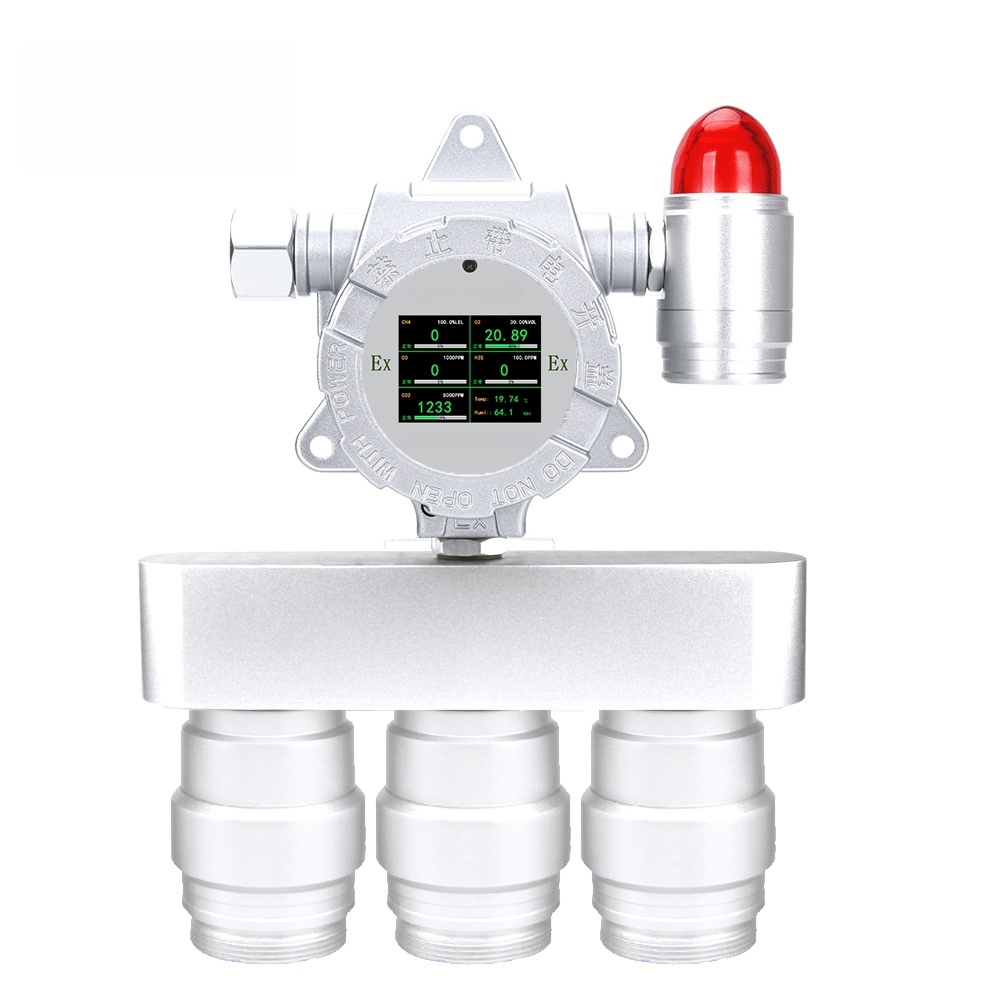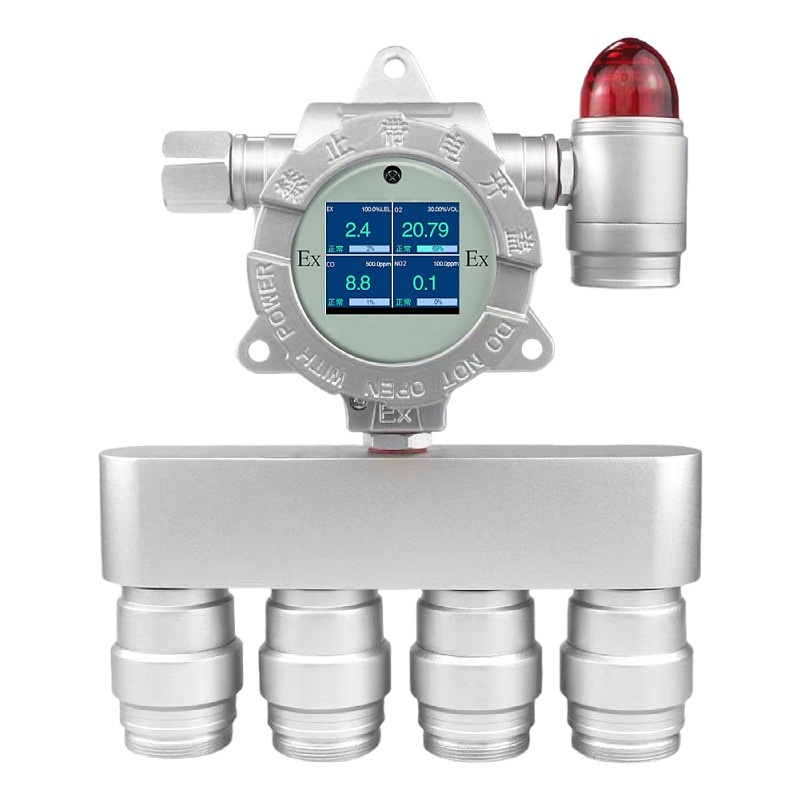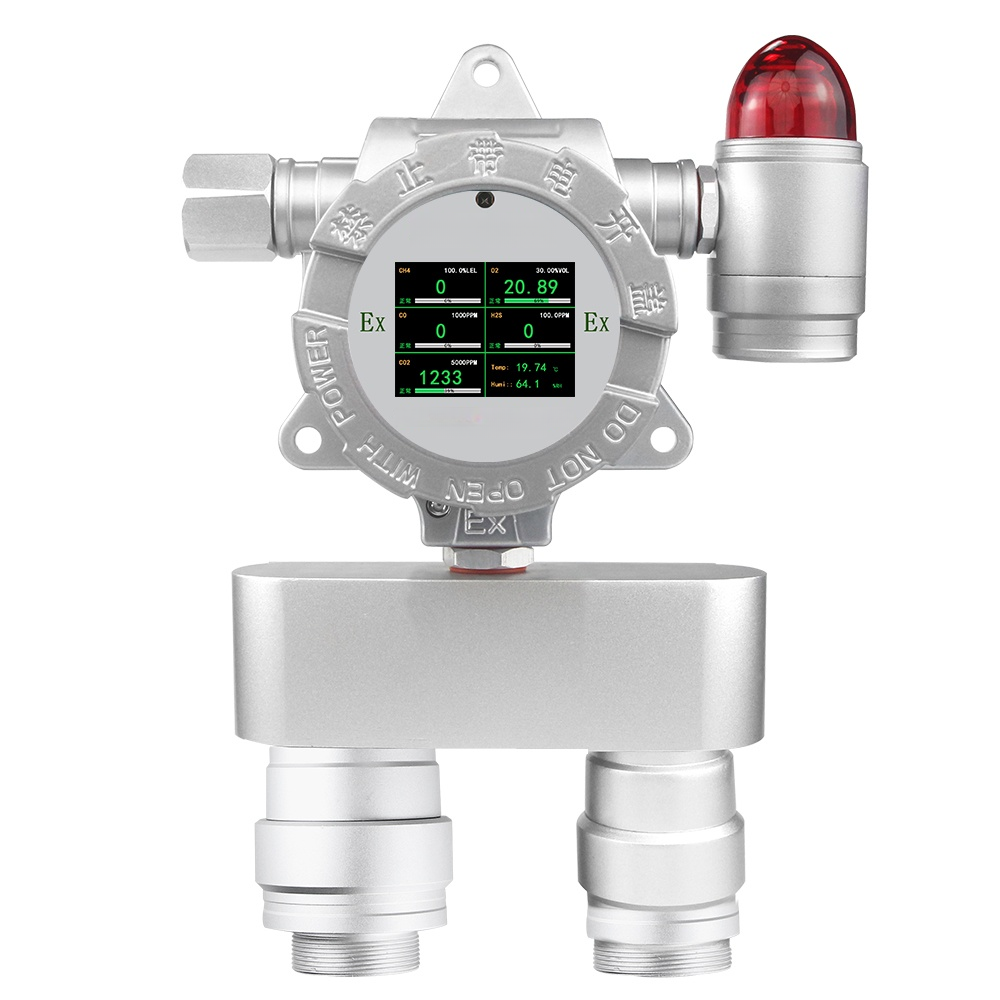1000A series fixed Multi Gas Detector is used for 24-hour continuous online monitoring of 2-8 gas concentrations on site. And temperature and humidity measurement. On-site display of concentration and sound and light alarm for exceeding the standard, 4-20mA/RS485 data transmission. Ensure safety in various environments.
For example, simultaneous monitoring of methane, hydrogen sulfide, carbon monoxide, oxygen, carbon dioxide, temperature, and humidity. Of course, the type of gas can be customized.
Features
- The sensor has good anti-interference performance and a service life of up to 3-5 years;
- The detection site has an on-site sound and light alarm function. Instant alarm when gas concentration exceeds the standard is a safety guarantee for dangerous on-site operations:
- The on-site large-screen LCD display with backlight intuitively displays gas concentration/type/unit/working status.
- Independent gas chamber, easy to replace the sensor.
- Replacement does not require on-site calibration. Automatic identification of key sensor parameters.
- Full-range temperature digital automatic tracking compensation to ensure measurement accuracy;
- Semiconductor nanotechnology ultra-low power consumption 32-bit micro-processor.
- The explosion-proof wiring method is suitable for various hazardous places and is compatible with various control alarms.
- It has an automatic recovery function to prevent damage to the instrument caused by external causes, human causes, natural disasters, etc.
- Automatic protection function against high-concentration gas shock.
Specifications
| Detection gas: | Methane, hydrogen sulfide, carbon monoxide, oxygen, carbon dioxide, temperature, humidity. Customization is supported |
| Detection range: | Methane 0-100%LEL, hydrogen sulfide 0-100PPM, carbon monoxide 0-500PPM, oxygen 0-30%VOL, carbon dioxide 0-5000PPM, temperature -20~120℃, humidity 0-100%RH. Other ranges can be customized |
| Resolution: | 0.1PPM higher resolution can be customized. Temperature 0.1℃, humidity: 1%RH. |
| Detection accuracy: | ≤±2%F.S (≤2% within the full range), temperature 0.5℃, humidity: 3%RH, higher accuracy can be customized |
| Working mode: | Fixed installation, online detection, diffusion measurement, pipeline, flow, pump suction optional |
| Installation method: | Pipeline, wall-mounted. The working pressure of the pipeline type is atmospheric pressure ±30%, and the pressure needs to be reduced if it exceeds the range |
| Response time: | T90≤20 seconds |
| Recovery time: | ≤30 seconds |
| Output signal: | Bus system RS485 (RTU), optional three (four) wire system 4~20mA, 0~20mA, 1~5V, 0~5V, 0~10V, wireless transmission |
| Alarm mode: | On-site sound and light alarm (optional), default 1 channel, optional 3-channel passive contact (dry node) output, three-level alarm, alarm point can be set |
| Working environment: | -40℃~+70℃ |
| Sample gas temperature: | -40℃~+70℃ (conventional), optional: -40℃~+400℃, -40℃~+800℃ (maximum 1300℃) |
| Relative humidity: | ≤10-95%RH (conventional) non-condensing occasions, optional: 10-99%RH for high temperature and high humidity occasions, please indicate when ordering, and pre-treatment system is required) |
| Working voltage: | 12~30V (DC direct current, the standard power supply of a single device is 24V, 1A or greater than 1A DC switching power supply) |
| Power supply reference: | 24V, 2.1A switching power supply can drive 40 toxic gas detectors, or 15 flammable and infrared gas detectors |
| Explosion-proof form: | Explosion-proof type ExdIICT6 |
| Connecting cable: | 4~20mA chooses three-core shielded cable, RS485 chooses four-core, single wire diameter ≥1.5mm when the distance exceeds 1000 meters; shielding layer is connected to the ground |
| Electrical interface: | 3/4NPT, optional M20X1.5 internal thread, 1/2NPT |
| Protection level: | IP66 waterproof splash and short-term rain, long-term rain requires optional rain cover or shell without display or specify when ordering |
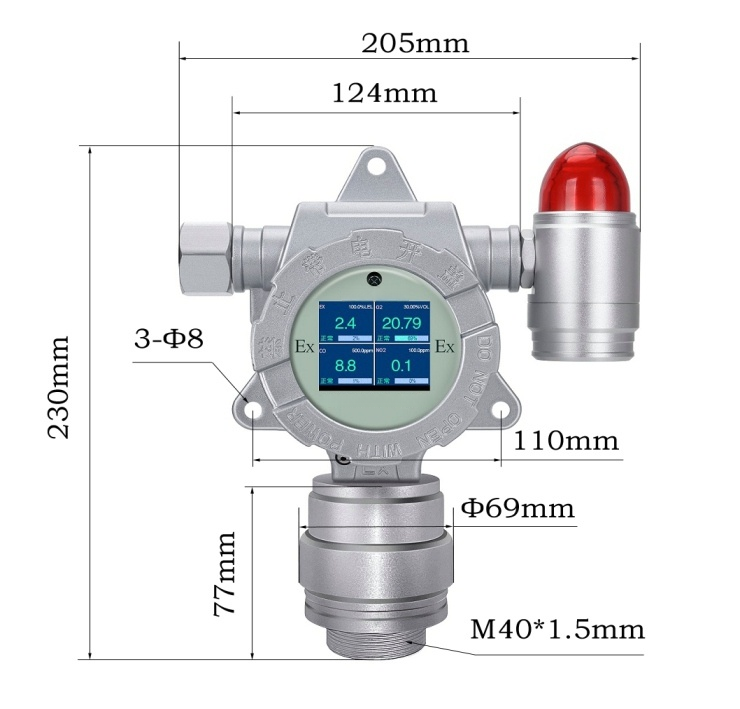
Detectable Gases and Measuring Ranges
| Detection gas | Range | Maximum allowable error | Minimum reading | Response time T90 |
| Combustible gas (EX) | 0-100%LEL | <±3%(F.S) | 0.1%LEL | ≤10 seconds |
| Combustible gas (EX) | 0-100%Vol | <±3%(F.S) | 0.1%Vol | ≤10 seconds |
| Methane (CH4) | 0-100%LEL | <±3%(F.S) | 0.1%LEL | ≤10 seconds |
| Methane (CH4) | 0-100%Vol | <±3%(F.S) | 0.1%Vol | ≤10 seconds |
| Oxygen (O2) | 0-30%Vol | <±3%(F.S) | 0.01%Vol | ≤10 seconds |
| Oxygen (O2) | 0-100%Vol | <±3%(F.S) | 0.01%Vol | ≤10 seconds |
| Oxygen (O2) | 0-5000ppm | <±3%(F.S) | 1ppm | ≤30 seconds |
| Nitrogen (N2) | 0-100%Vol | <±3%(F.S) | 0.01%Vol | ≤10 seconds |
| Carbon monoxide (CO) | 0-100ppm | <±3%(F.S) | 0.1ppm | ≤25 seconds |
| Carbon monoxide (CO) | 0-1000ppm | <±3%(F.S) | 0.1ppm | ≤25 seconds |
| Carbon monoxide (CO) | 0-2000ppm | <±3%(F.S) | 0.1ppm | ≤25 seconds |
| Carbon monoxide (CO) | 0-20000ppm | <±3%(F.S) | 1ppm | ≤25 seconds |
| Carbon monoxide (CO) | 0-100000ppm | <±3%(F.S) | 1ppm | ≤20 seconds |
| Carbon dioxide (CO2) | 0-500ppm | <±3%(F.S) | 1ppm | ≤20 seconds |
| Carbon dioxide (CO2) | 0-2000ppm | <±3%(F.S) | 1ppm | ≤20 seconds |
| Carbon dioxide (CO2) | 0-5000ppm | <±3%(F.S) | 1ppm | ≤30 seconds |
| Carbon dioxide (CO2) | 0-50000ppm | <±3%(F.S) | 1ppm | ≤30 seconds |
| Carbon dioxide (CO2) | 0-20%Vol | <±3%(F.S) | 0.01%Vol | ≤30 seconds |
| Carbon dioxide (CO2) | 0-100%Vol | <±3%(F.S) | 0.01%Vol | ≤30 seconds |
| Carbon dioxide (CO2) | 0-10ppm | <±3%(F.S) | 0.001ppm | ≤30 seconds |
| Formaldehyde (CH2O) | 0-10ppm | <±3%(F.S) | 0.01ppm | ≤30 seconds |
| Formaldehyde (CH2O) | 0-100ppm | <±3%(F.S) | 0.01ppm | ≤45 seconds |
| Formaldehyde (CH2O) | 0-1000ppm | <±3%(F.S) | 1ppm | ≤20 seconds |
| Ozone (O3) | 0-1ppm | <±3%(F.S) | 0.001ppm | ≤20 seconds |
| Ozone (O3) | 0-5ppm | <±3%(F.S) | 0.001ppm | ≤20 seconds |
| Ozone (O3) | 0-50ppm | <±3%(F.S) | 0.01ppm | ≤30 seconds |
| Ozone (O3) | 0-100ppm | <±3%(F.S) | 0.01ppm | ≤30 seconds |
| Ozone (O3) | 0-2000ppm | <±3%(F.S) | 0.1ppm | ≤30 seconds |
| Ozone (O3) | 0-30000ppm | <±3%(F.S) | 1ppm | ≤30 seconds |
| Ozone (O3) | 0-20mg/L | <±3%(F.S) | 0.01mg/L | ≤30 seconds |
| Ozone water (O3) | 0-20mg/L | <±3%(F.S) | 0.01mg/L | ≤30 seconds |
| Hydrogen sulfide (H2S) | 0-10ppm | <±3%(F.S) | 0.001ppm | ≤30 seconds |
| Hydrogen sulfide (H2S) | 0-50ppm | <±3%(F.S) | 0.01ppm | ≤30 seconds |
| Hydrogen sulfide (H2S) | 0-100ppm | <±3%(F.S) | 0.01ppm | ≤30 seconds |
| Hydrogen sulfide (H2S) | 0-2000ppm | <±3%(F.S) | 0.1ppm | ≤30 seconds |
| Hydrogen sulfide (H2S) | 0-10000ppm | <±3%(F.S) | 1ppm | ≤30 seconds |
| Sulfur dioxide (SO2) | 0-10ppm | <±3%(F.S) | 0.001ppm | ≤45 seconds |
| Sulfur dioxide (SO2) | 0-20ppm | <±3%(F.S) | 0.01ppm | ≤30 seconds |
| Sulfur dioxide (SO2) | 0-100ppm | <±3%(F.S) | 0.01ppm | ≤30 seconds |
| Sulfur dioxide (SO2) | 0-500ppm | <±3%(F.S) | 0.1ppm | ≤30 seconds |
| Sulfur dioxide (SO2) | 0-2000ppm | <±3%(F.S) | 0.1ppm | ≤30 seconds |
| Sulfur dioxide (SO2) | 0-10000ppm | <±3%(F.S) | 1ppm | ≤30 seconds |
| Nitrogen monoxide (NO) | 0-10ppm | <±3%(F.S) | 0.001ppm | ≤30 seconds |
| Nitrogen monoxide (NO) | 0-100ppm | <±3%(F.S) | 0.01ppm | ≤30 seconds |
| Nitrogen monoxide (NO) | 0-2000ppm | <±3%(F.S) | 0.1ppm | ≤30 seconds |
| Nitrogen dioxide (NO2) | 0-5000ppm | <±3%(F.S) | 1ppm | ≤30 seconds |
| Nitrogen dioxide (NO2) | 0-10ppm | <±3%(F.S) | 0.001ppm | ≤30 seconds |
| Nitrogen dioxide (NO2) | 0-100ppm | <±3%(F.S) | 0.01ppm | ≤30 seconds |
| Nitrogen dioxide (NO2) | 0-1000ppm | <±3%(F.S) | 0.1ppm | ≤25 seconds |
| Nitrogen dioxide (NO2) | 0-5000ppm | <±3%(F.S) | 1ppm | ≤25 seconds |
| Nitrogen dioxide (NO2) | 0-10ppm | <±3%(F.S) | 0.001ppm | ≤30 seconds |
| Nitrogen oxides (NOX) | 0-100ppm | <±3%(F.S) | 0.01ppm | ≤30 seconds |
| Nitrogen oxides (NOX) | 0-2000ppm | <±3%(F.S) | 0.1ppm | ≤30 seconds |
| Nitrogen oxides (NOX) | 0-5000ppm | <±3%(F.S) | 1ppm | ≤30 seconds |
| Chlorine (CL2) | 0-10ppm | <±3%(F.S) | 0.001ppm | ≤30 seconds |
| Chlorine (CL2) | 0-20ppm | <±3%(F.S) | 0.01ppm | ≤30 seconds |
| Chlorine (CL2) | 0-200ppm | <±3%(F.S) | 0.1ppm | ≤30 seconds |
| Chlorine (CL2) | 0-2000ppm | <±3%(F.S) | 0.1ppm | ≤30 seconds |
| Ammonia (NH3) | 0-50ppm | <±3%(F.S) | 0.01ppm | ≤30 seconds |
| Ammonia (NH3) | 0-100ppm | <±3%(F.S) | 0.01ppm | ≤30 seconds |
| Ammonia (NH3) | 0-1000ppm | <±3%(F.S) | 0.1ppm | ≤30 seconds |
| Ammonia (NH3) | 0-5000ppm | <±3%(F.S) | 1ppm | ≤30 seconds |
| Ammonia (NH3) | 0-100%LEL | <±3%(F.S) | 0.1%LEL | ≤30 seconds |
| Hydrogen (H2) | 0-100%LEL | <±3%(F.S) | 0.1%LEL | ≤30 seconds |
| Hydrogen (H2) | 0-1000ppm | <±3%(F.S) | 0.1ppm | ≤30 seconds |
| Hydrogen (H2) | 0-20000ppm | <±3%(F.S) | 1ppm | ≤30 seconds |
| Hydrogen (H2) | 0-40000ppm | <±3%(F.S) | 1ppm | ≤30 seconds |
| Hydrogen (H2) | 0-100%Vol | <±3%(F.S) | 0.01%Vol | ≤30 seconds |
| Helium (He) | 0-100%Vol | <±3%(F.S) | 0.01%Vol | ≤10 seconds |
| Argon (Ar) | 0-100%Vol | <±3%(F.S) | 0.01%Vol | ≤10 seconds |
| Xenon (Xe) | 0-100%Vol | <±3%(F.S) | 0.01%Vol | ≤30 seconds |
| Hydrogen cyanide (HCN) | 0-30ppm | <±3%(F.S) | 0.01ppm | ≤30 seconds |
| Hydrogen cyanide (HCN) | 0-100ppm | <±3%(F.S) | 0.01ppm | ≤30 seconds |
| Hydrogen chloride (HCL) | 0-20ppm | <±3%(F.S) | 0.01ppm | ≤30 seconds |
| Hydrogen chloride (HCL) | 0-200ppm | <±3%(F.S) | 0.1ppm | ≤20 seconds |
| Phosphine (PH3) | 0-5ppm | <±3%(F.S) | 0.001ppm | ≤20 seconds |
| Phosphine (PH3) | 0-25ppm | <±3%(F.S) | 0.01ppm | ≤20 seconds |
| Phosphine (PH3) | 0-2000ppm | <±3%(F.S) | 1ppm | ≤30 seconds |
| Chlorine dioxide (CLO2) | 0-1ppm | <±3%(F.S) | 0.001ppm | ≤30 seconds |
| Chlorine dioxide (CLO2) | 0-10ppm | <±3%(F.S) | 0.01ppm | ≤30 seconds |
| Chlorine dioxide (CLO2) | 0-200ppm | <±3%(F.S) | 0.01ppm | ≤30 seconds |
| Ethylene oxide (ETO) | 0-100ppm | <±3%(F.S) | 0.01ppm | ≤30 seconds |
| Ethylene oxide (ETO) | 0-1000ppm | <±3%(F.S) | 0.1ppm | ≤30 seconds |
| Ethylene oxide (ETO) | 0-100%LEL | <±3%(F.S) | 1%LEL | ≤30 seconds |
| Phosgene (COCL2) | 0-1ppm | <±3%(F.S) | 0.001ppm | ≤30 seconds |
| Phosgene (COCL2) | 0-50ppm | <±3%(F.S) | 0.01ppm | ≤30 seconds |
| Silane (SiH4) | 0-1ppm | <±3%(F.S) | 0.001ppm | ≤30 seconds |
| Silane (SiH4) | 0-50ppm | <±3%(F.S) | 0.01ppm | ≤30 seconds |
| Fluorine (F2) | 0-1ppm | <±3%(F.S) | 0.001ppm | ≤30 seconds |
| Fluorine (F2) | 0-10ppm | <±3%(F.S) | 0.01ppm | ≤30 seconds |
| Fluorine (F2) | 0-50ppm | <±3%(F.S) | 0.01ppm | ≤30 seconds |
| Hydrogen fluoride (HF) | 0-10ppm | <±3%(F.S) | 0.01ppm | ≤20 seconds |
| Hydrogen fluoride (HF) | 0-50ppm | <±3%(F.S) | 0.01ppm | ≤20 seconds |
| Hydrogen bromide (HBr) | 0-50ppm | <±3%(F.S) | 0.01ppm | ≤30 seconds |
| Diborane (B2H6) | 0-10ppm | <±3%(F.S) | 0.001ppm | ≤30 seconds |
| Arsine (AsH3) | 0-1ppm | <±3%(F.S) | 0.001ppm | ≤30 seconds |
| Arsine (AsH3) | 0-10ppm | <±3%(F.S) | 0.01ppm | ≤30 seconds |
| Arsine (AsH3) | 0-50ppm | <±3%(F.S) | 0.01ppm | ≤30 seconds |
| Germane (GeH4) | 0-2ppm | <±3%(F.S) | 0.001ppm | ≤30 seconds |
| Germane (GeH4) | 0-20ppm | <±3%(F.S) | 0.01ppm | ≤30 seconds |
| Hydrazine (N2H4) | 0-1ppm | <±3%(F.S) | 0.001ppm | ≤30 seconds |
| Hydrazine (N2H4) | 0-300ppm | <±3%(F.S) | 0.1ppm | ≤30 seconds |
| Tetrahydrothiophene (THT) | 0-100mg/m3 | <±3%(F.S) | 0.01mg/m3 | ≤30 seconds |
| Bromine (Br2) | 0-10ppm | <±3%(F.S) | 0.001ppm | ≤30 seconds |
| Bromine (Br2) | 0-100ppm | <±3%(F.S) | 0.01ppm | ≤30 seconds |
| Bromine (Br2) | 0-2000ppm | <±3%(F.S) | 1ppm | ≤30 seconds |
| Acetylene (C2H2) | 0-100%LEL | <±3%(F.S) | 0.1%LEL | ≤30 seconds |
| Acetylene (C2H2) | 0-100ppm | <±3%(F.S) | 0.01ppm | ≤30 seconds |
| Acetylene (C2H2) | 0-1000ppm | <±3%(F.S) | 0.1ppm | ≤30 seconds |
| Ethylene (C2H4) | 0-100%LEL | <±3%(F.S) | 0.1%LEL | ≤30 seconds |
| Ethylene (C2H4) | 0-100ppm | <±3%(F.S) | 0.01ppm | ≤30 seconds |
| Ethylene (C2H4) | 0-2000ppm | <±3%(F.S) | 0.1ppm | ≤30 seconds |
| Acetaldehyde (C2H4O) | 0-10ppm | <±3%(F.S) | 0.01ppm | ≤30 seconds |
| Ethanol (C2H6O) | 0-100ppm | <±3%(F.S) | 0.01ppm | ≤30 seconds |
| Ethanol (C2H6O) | 0-2000ppm | <±3%(F.S) | 1ppm | ≤60 seconds |
| Methanol (CH6O) | 0-100ppm | <±3%(F.S) | 0.01ppm | ≤30 seconds |
| Methanol (CH6O) | 0-2000ppm | <±3%(F.S) | 1ppm | ≤30 seconds |
| Carbon disulfide (CS2) | 0-50ppm | <±3%(F.S) | 0.01ppm | ≤30 seconds |
| Carbon disulfide (CS2) | 0-5000ppm | <±3%(F.S) | 0.01ppm | ≤30 seconds |
| Acrylonitrile (C3H3N) | 0-50ppm | <±3%(F.S) | 0.01ppm | ≤30 seconds |
| Acrylonitrile (C3H3N) | 0-2000ppm | <±3%(F.S) | 1ppm | ≤30 seconds |
| Methylamine (CH5N) | 0-50ppm | <±3%(F.S) | 0.01ppm | ≤30 seconds |
| I2 | 0-50ppm | <±3%(F.S) | 0.01ppm | ≤30 seconds |
| Styrene (C8H8) | 0-200ppm | <±3%(F.S) | 0.1ppm | ≤30 seconds |
| Styrene (C8H8) | 0-5000ppm | <±3%(F.S) | 1ppm | ≤30 seconds |
| Vinyl chloride (C2H3CL) | 0-100ppm | <±3%(F.S) | 0.01ppm | ≤30 seconds |
| Trichloroethylene (C2HCL3) | 0-100ppm | <±3%(F.S) | 0.01ppm | ≤30 seconds |
| Tetrachloroethylene (C2CL4) | 0-100ppm | <±3%(F.S) | 0.01ppm | ≤30 seconds |
| Laughing gas (N2O) | 0-100ppm | <±3%(F.S) | 0.01ppm | ≤30 seconds |
| Nitrogen trifluoride (NF3) | 0-100ppm | <±3%(F.S) | 0.01ppm | ≤30 seconds |
| Hydrogen peroxide (H2O2) | 0-100ppm | <±3%(F.S) | 0.01ppm | ≤30 seconds |
| Sulfuryl fluoride (SO2F2) | 0-100ppm | <±3%(F.S) | 0.01ppm | ≤30 seconds |
| Sulfuryl fluoride (SO2F2) | 0-30000ppm | <±3%(F.S) | 1ppm | ≤30 seconds |
| Sulfuryl fluoride (SO2F2) | 0-200g/m3 | <±3%(F.S) | 0.1g/m3 | ≤30 seconds |
| Sulfuryl fluoride (SO2F2) | 0-100ppm | <±3%(F.S) | 0.01ppm | ≤30 seconds |
| Sulfuryl fluoride (SO2F2) | 0-5000ppm | <±3%(F.S) | 1ppm | ≤30 seconds |
| Sulfuryl fluoride (SO2F2) | 0-10000ppm | <±3%(F.S) | 1ppm | ≤30 seconds |
| C6H6 | 0-10ppm | <±3%(F.S) | 0.01ppm | ≤30 seconds |
| C6H6 | 0-100ppm | <±3%(F.S) | 0.01ppm | ≤30 seconds |
| C6H6 | 0-2000ppm | <±3%(F.S) | 1ppm | ≤30 seconds |
How does a fixed gas detector achieve remote monitoring?
Fixed Multi Gas Detector achieves remote monitoring through a series of technologies and methods. The following is a detailed analysis of the specific implementation methods:
1. Wired network transmission
Connection principle: Connect the gas detector to the enterprise’s internal network or the Internet through an Ethernet cable. The monitoring data is transmitted from the gas detector to the data collector and then sent to the remote monitoring center server stably and quickly through the wired network.
Applicable scenarios: industrial parks with relatively concentrated layouts and complete network infrastructure. This method ensures stability and high rate of data transmission.
2. Wireless network transmission
Technical basis: With the help of cellular network technologies such as 4G and 5G, or wireless communication protocols such as Wi-Fi and LoRa, remote data transmission is achieved.
Applicable scenarios: remote factory areas with inconvenient wiring or monitoring scenarios with high flexibility requirements. 4G/5G networks are suitable for long-distance data transmission. Even if the monitoring equipment is deployed far away from the monitoring center, data can be sent to the cloud or remote monitoring platform in a timely manner.
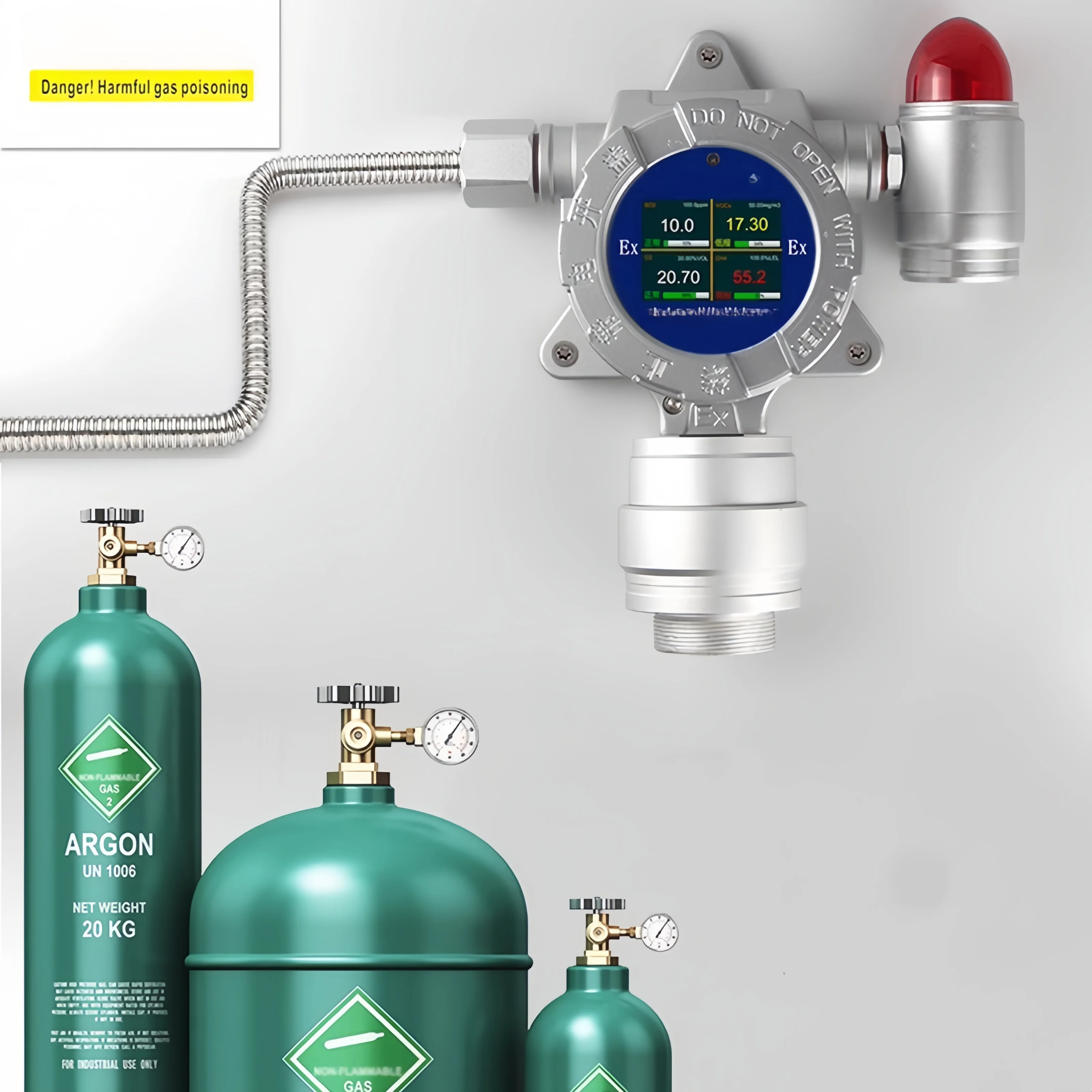
3. Data display and monitoring platform
Web-based monitoring platform: users access a specific domain name through a browser and enter an account and password to log in to the monitoring platform. The platform displays real-time gas data, historical data, alarm information, etc. in the form of intuitive charts and maps. As long as there is a network connection, users can view the monitoring situation through computers, tablets and other devices wherever they are.
Mobile APP: In order to facilitate monitoring anytime and anywhere, many fixed Multi Gas Detectors have developed exclusive mobile APPs. Users can install APPs on their mobile phones to achieve functions similar to those of the Web platform. Such as real-time data viewing, alarm push, device management, etc.
4. System compatibility and scalability
Compatible with multiple systems: Fixed Multi Gas Detector is usually compatible with various secondary meters, data acquisition modules, PLC (programmable logic controller), DCS (distributed control system), etc., which is easy to integrate into existing automation systems.
Scalability: The detector supports multiple output signals (such as RS485, 4~20mA, etc.). Customizable voltage output, with wireless module, can achieve longer-distance wireless transmission. In addition, by selecting controllers and other equipment, multiple detectors can be monitored at the same time to improve monitoring efficiency.
The fixed Multi Gas Detector realizes remote monitoring functions through wired and wireless network transmission, data display and monitoring platform, system compatibility and scalability and other technologies and methods. These functions play an important role in practical applications and improve the efficiency and accuracy of industrial safety monitoring.
If you need to perform gas concentration, gas leakage and other detections, please feel free to contact our sales engineer!


